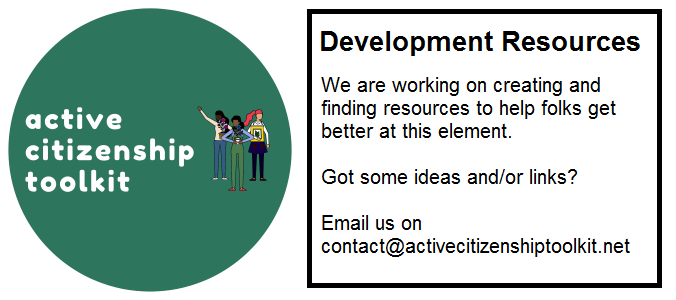Element Descriptor
After you have burnt out, and licked your wounds, and found ways of coping, you may want to re-engage, on a new footing. But how to recover in meaningful ways, that leave you changed-but-strong, rather than likely to undergo the same trauma again? Without this, it is Groundhog Day all over again…
Level descriptors
| Novice | Practitioner | Expert | Ninja |
|---|---|---|---|
| You know the signs of burnout, and how an ounce or three of prevention is worth a pound of cure. You also can speak about the pathologies in activist culture than actively encourage burnout. You’re able to talk people through how to disengage, what to do in the down/away time and how to judge how/when they might be able to come back… | You are able to help a small number of people with different levels of burnout find ways through/past those feelings and into new forms of active citizenship that don’t end in banging your head against a brick wall. | You are able to help numbers of people at different levels of burnout and with different resources available to them (personal, social etc) to overcome the scar tissue/burns experienced in previous bouts of active citizenship. You’re able to help them to help themselves come back different, wiser and maybe stronger. … | They call you Phoenix, because you can turn ashes into birds “If the Phoenix bird can fly then so can I” You can help serious numbers of diverse indivduals whose burnout has different causes to get back to a level of active citizenship that is both sensible and sustainable. You write books and articles about this stuff… |
Element Overview Essay
This is a draft. If something doesn’t make sense, or you see typos, or if you have further ideas, please email us on contact@activecitizenshiptoolkit.net
There are two reasons that burnout recovery is done badly or not at all Number one, few people recover from burnout within the group that burnt them out, or that they were in when they burnt out. And so you don’t learn and watch as people do their recovery.
The other obvious reason is that no two recoveries are going to be the same within an individual or across individuals, because the causes of the burnout will be different, the way it manifested itself and the resources that individuals have within themselves, within their broader networks, the sense that they made of those feelings of burnout will be different.
The consequences of not supporting or doing burnout recovery well, is, the people stay burnt out. They stay entirely unavailable to social movement organisations. And the story of their burnout can be told and distorted and exaggerated format for years to come, as folk tales to warn about what happens to you when you get heavily involved in something as an active citizen. And this of course has a chilling effect on recruitment and retention and it leaves are lords and masters even more unchallenged than they are now.
So what is to be done? Well, number one, understand that there’s no single pathway back from burnout and that there’s no timetable or schedule. Well, it’s been three months now and therefore you should be able to do X, that it’s not linear. That it will happen in fits and starts and will include periods of status or even going what is perceived to be going backwards.
That it will require compassionate support and that expecting too much or too little of someone can damage that there will not be a return to the “good old days”, which was not always that good because if they were, how come the person sent out? It’s also an opportunity, of course, (one that the groups are probably not going to take i)t, to consider what it is in their culture that either encouraged or facilitated, or condoned or failed to stop the burnout in the first place, is there some competitive/performative martyrdom going on? And the person who burn out just burnt out just happens to have won that contest the last time round?
Development Resources

Assessment Resources

